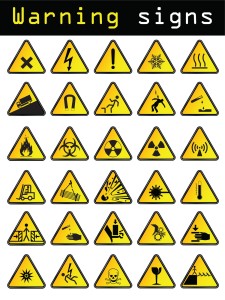Warning Signs
 A little boy was in the checkout line at Walmart with his Mom. Right ahead of them was a woman waiting to pay her bill. All of a sudden her phone began to beep. The little boy got a panicked look on his face and blurted out, “Look out Mom, she’s backing up!” LOL. Paints quite a visual….doesn’t it?
A little boy was in the checkout line at Walmart with his Mom. Right ahead of them was a woman waiting to pay her bill. All of a sudden her phone began to beep. The little boy got a panicked look on his face and blurted out, “Look out Mom, she’s backing up!” LOL. Paints quite a visual….doesn’t it?
There are all types of signs that warn us to stop, yield, slow down, etc. Some of them are literal signs…and some of them are not so obvious. I have been doing intervention work with elementary school kids who are behind academically. We are trained to observe and document behavior that is abnormal. These kids have been diagnosed with learning disabilities already. They are the ones who are getting immediate help.
The kids I am really concerned about are the ones who have not been diagnosed yet and you can hear their silent screams a mile away. You can see the anger, the sadness, and lack of hope in their eyes. Those are the ones that as an educator and a parent I try to help in spite of the system.
Dr. Phil says, “When someone shows you who they are…believe it.” That is great advice in relationships. Pay attention to the warning signs. There are severe and sometimes life-long consequences for ignoring the signs. With children, kids have to learn early how to control their emotions. Some of this will come with peer pressure, but the majority of it comes from the parents and educators who set the standards. The sad part of this is that too many kids have no standards set at home…or they are so low they don’t matter.
Our role as educators is to recognize the warning signs and do what we can to help get them and keep them on the right path. It is a continual battle, it seems, but one that has great reward when you see the child that was isolated become fully functioning. My hope and prayer is that we as educators and parents not just recognize the warning signs, but that we do everything humanly possible to help kids learn to control their own behavior, actively engage in the learning process, and never lose hope. We can’t expect them to do this on their own…and the schools certainly can’t do it without some support from the parents. Please pay attention and accept responsibility for the signs.
Shalom!
Dan Skognes
Thanks, Dan.
I like the emphasis on behavior modification rather than immediately and mindlessly administering medication to troubled children.
As you said, this places the responsibility on parents, educators, and other adults to exemplify good behavior and expect it from children.
Given their relationship to the child, each adult has their own ways in which they can accomplish this goal.
Thanks again.
Thanks Cliff. I appreciate your feedback. NNTR.